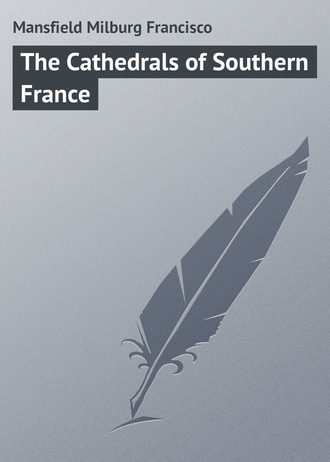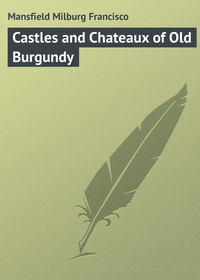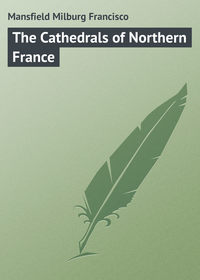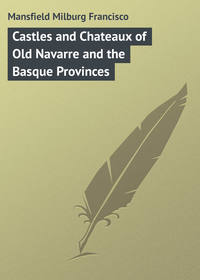 полная версия
полная версияThe Cathedrals of Southern France
As a centre of Christianity, Castres is very ancient. In 647 there was a Benedictine abbey here. The bishopric, however, did not come into being until 1317, and was suppressed in 1790.
XIX
NOTRE DAME DE RODEZ
The cathedral at Rodez, whose diocese dates from the fifth century and whose first bishop was St. Amand, is, in a way, reminiscent – in its majesty of outline and dominant situation – of that at Albi.
It is not, however, after the same manner, but resembles it more particularly with respect to its west façade, which is unpierced in its lower stages by either doorway or window.
Here, too, the entrance is midway in its length, and its front presents that sheer flank of walled barrier which is suggestive of nothing but a fortification.
This great church – for it is truly great, pure and simple – makes up in width what it lacks in length. Its nave and aisles are just covered by a span of one hundred and twenty feet, – a greater dimension than is possessed by Chartres or Rouen, and nearly as great as Paris or Amiens.
Altogether Notre Dame de Rodez is a most pleasing church, though conglomerate as to its architecture, and as bad, with respect to the Renaissance gable of its façade, as any contemporary work in the same style.
Rodez lacks, however, the great enfolding tower central of Albi.
This mellow and warm-toned cathedral, from its beginnings in the latter years of the thirteenth century to the time when the Renaissance cast its dastardly spell over the genius who inspired its original plan, was the result of the persevering though intermittent work of three centuries, and even then the two western towers were left incomplete.
This perhaps was fortunate; otherwise they might have been topped with such an excrescence as looms up over the doorless west façade.
The Gascon compares the pyramidal roofs which cap either tower – and with some justness, too – to the pyramids of Egypt, and for that reason the towers are, to him, the most wonderful in the universe. Subtle humour this, and the observer will have little difficulty in tracing the analogy.
Still, they really are preferable, as a decorative feature, to the tomb-like headboard which surmounts the central gable which they flank. The ground-plan is singularly uniform, with transepts scarcely defined – except in the interior arrangements – and yet not wholly absent.
The elaborate tower, called often and with some justification the beffroi, which flanks, or rather indicates, the northerly transept, is hardly pure as to its Gothic details, but it is a magnificent work nevertheless.
It dates from 1510, is two hundred and sixty-five feet high, and is typical of most of the late pointed work of its era. The final stage is octagonal and is surmounted by a statue of the Virgin surrounded by the Evangelists. This statue may or may not be a worthy work of art; it is too elevated, however, for one to decide.
The decorations of the west front, except for the tombstone-like Renaissance gable, are mainly of the same period as the north transept tower, and while perhaps ultra-florid, certainly make a fine appearance when viewed across the Place d'Armes.
This west front, moreover, possesses that unusual attribute of a southern church, an elaborate Gothic rose window; and, though it does not equal in size or design such magnificent examples as are seen in the north, at Reims, Amiens, or Chartres, is, after all, a notable detail of its kind.
The choir, chevet, and apside are of massive building, though not lacking grace, in spite of the absence of the arcs-boutants of the best Gothic.
Numerous grotesque gargoyles dot the eaves and gables, though whether of the spout variety or mere symbols of superstition one can hardly tell with accuracy when viewed from the ground level.
The north and south portals of the transepts are of a florid nature, after the manner of most of the decorations throughout the structure, and are acceptable evidence of the ingenious craft of the stone-carver, if nothing more.
The workmanship of these details, however, does not rise to the heights achieved by the architect who outlined the plan and foundation upon which they were latterly imposed. They are, too, sadly disfigured, the tympanum in the north portal having been disgracefully ravished.
The interior arrangements are doubly impressive, not only from the effect of great size, but from the novel colour effect – a sort of dull, glowing pink which seems to pervade the very atmosphere, an effect which contrasts strangely with the colder atmosphere of the Gothic churches of the north. A curious feature to be noted here is that the sustaining walls of the vault rest directly on piers sans capitals; as effective, no doubt, as the conventional manner, but in this case hardly as pleasing.
Two altars, one at either end of nave and choir, duplicate the arrangement seen at Albi.
The organ buffet, too, is of the same massiveness and elaborateness, and is consequently an object of supreme pride to the local authorities.
It seems difficult to make these useful and necessary adjuncts to a church interior of the quality of beauty shared by most other accessories, such as screens, altars, and choir-stalls, which, though often of the contemporary Renaissance period, are generally beautiful in themselves. The organ-case, however, seems to run either to size, heaviness, or grotesqueness, or a combination of all. This is true in this case, where its great size, and plentifully besprinkled rococo ornament, and unpleasantly dull and dingy "pipes" are of no æsthetic value whatever. The organ, moreover, occupies the unusual position – in a French church – of being over the western doorway.
The nave is of extreme height, one hundred and ten feet, and is of unusual width, as are also the aisles.
The rose window, before remarked, shows well from the inside, though its glass is not notable.
A series of badly arched lancets in the choir are ungraceful and not in keeping with the other constructive details. The delicately sculptured and foliaged screen or jubé at the crossing is a late fifteenth-century work.
In one of the chapels is now to be seen, in mutilated fragments, the ancient sixteenth-century clôture du chœur. It was a remarkable and elaborate work of bizarre stone-carving, which to-day has been reconstructed in some measure approaching its former completeness by the use of still other fragments taken from the episcopal palace. The chief feature as to completeness and perfection is the doorway, which bears two lengthy inscriptions in Latin. The facing of the clôture throughout is covered with a range of pilasters in Arabesque, but the niches between are to-day bare of their statues, if they ever really possessed them.
The choir-stalls and bishop's throne in carved wood are excellent, as also an elaborately carved wooden grille of a mixed Arabesque and Gothic design.
There are four other chapel or alcove screens very nearly as elaborate; all of which features, taken in conjunction one with the other, form an extensive series of embellishments such as is seldom met with.
Two fourteenth-century monuments to former prelates are situated in adjoining chapels, and a still more luxurious work of the same period – the tomb of Gilbert de Cantobre – is beneath an extensive altar which has supposedly Byzantine ornament of the tenth century.
Rodez was the seat of a bishop (St. Amand) as early as the fifth century.
Then, as now, the diocese was a suffragan of Albi, whose first bishop, St. Clair, came to the mother-see in the century previous.
XX
STE. CÉCILE D'ALBI
The cathedral of Ste. Cécile d'Albi is one of the most interesting, as well as one of the most curious, in all France. It possesses a quality, rare among churches, which gives it at once the aspect of both a church and a fortress.
As the representative of a type, it stands at the very head of the splendid fortress-churches of feudal times. The remarkable disposition of its plan is somewhat reflected in the neighbouring cathedral at Rodez and in the church at Esnades, in the Department of the Charente-Inférieure.
In the severe and aggressive lines of the easterly, or choir, end, it also resembles the famous church of St. Francis at Assisi, and the ruined church of Sainte Sophie at Famagousta in the Island of Cyprus.
It has been likened by the imaginative French – and it needs not so very great a stretch of the imagination, either – to an immense vessel. Certainly its lines and proportions somewhat approach such a form; as much so as those of Notre Dame de Noyon, which Stevenson likened to an old-time craft with a high poop. A less æsthetic comparison has been made with a locomotive of gigantic size, and, truth to tell, it is not unlike that, either, with its advancing tower.
The extreme width of the great nave of this church is nearly ninety feet, and its body is constructed, after an unusual manner, of a warm, rosy-coloured brick. In fact the only considerable portions of the structure not so done are the clôture of the choir, the window-mullions, and the flamboyant Gothic porch of the south side.
By reason of its uncommon constructive elements, – though by no means is it the sole representative of its kind in the south of France, – Ste. Cécile stands forth as the most considerable edifice of its kind among those which were constructed after this manner of Roman antiquity.
Brickwork of this nature, as is well known, is very enduring, and it therefore makes much for the lasting qualities of a structure so built; much more so, in fact, than the crumbling soft stone which is often used, and which crumbles before the march of time like lead in a furnace.
Ste. Cécile was begun in 1282, on the ruins of the ancient church of St. Croix. It came to its completion during the latter years of the fourteenth century, when it stood much as it does to-day, grim and strong, but very beautiful.
The only exterior addition of a later time is the before-remarked florid south porch. This baldaquin is very charmingly worked in a light brown stone, and, while flamboyant to an ultra degree, is more graceful in design and execution than most works of a contemporary era which are welded to a stone fabric whose constructive and decorative details are of quite a distinctly different species. In other words, it composes and adds a graceful beauty to the brick fabric of this great church; but likely enough it would offend exceedingly were it brought into juxtaposition with the more slim lines of early Gothic. Its detail here is the very culmination of the height to which Gothic rose before its final debasement, and, in its spirited non-contemporaneous admixture with the firmly planted brick walls which form its background, may be reckoned as a baroque in art rather than as a thing outré or misplaced.
In further explanation of the peculiar fortress-like qualities possessed by Ste. Cécile, it may be mentioned here that it was the outcome of a desire for the safety of the church and its adherents which caused it to take this form. It was the direct result of the terrible wars of the Albigenses, and the political and social conditions of the age in which it was built, – the days when the Church was truly militant.
Here, too, to a more impressive extent than elsewhere, if we except the papal palace at Avignon, the episcopal residence as well takes on an aspect which is not far different from that possessed by some of the secular châteaux of feudal times. It closely adjoins the cathedral, which should perhaps dispute this. In reality, however, it does not, and its walls and foundations look far more worldly than they do devout. As to impressiveness, this stronghold of a bishop's palace is thoroughly in keeping with the cathedral itself, and the frowning battlement of its veritable donjon and walls and ramparts suggests a deal more than the mere name by which it is known would justify. Such use as it was previously put to was well served, and the history of the troublous times of the mediæval ages, when the wars of the Protestants, "the cursed Albigenses," and the natural political and social dissensions, form a chapter around which one could weave much of the history of this majestic cathedral and its walled and fortified environment.
The interior of the cathedral will appeal first of all by its very grand proportions, and next by the curious ill-mannered decorations with which the walls are entirely covered. There is a certain gloom in this interior, induced by the fact that the windows are mere elongated slits in the walls. There are no aisles, no triforium, and no clerestory; nothing but a vast expanse of wall with bizarre decorations and these unusual window piercings. The arrangement of the openings in the tower are even more remarkable – what there are of them, for in truth it is here that the greatest likeness to a fortification is seen. In the lower stages of the tower there are no openings whatever, while above they are practically nothing but loopholes.
The fine choir-screen, in stone, is considered one of the most beautiful and magnificent in France, and to see it is to believe the statement. The entire clôture of the choir is a wonderful piece of stonework, and the hundred and twenty stalls, which are within its walls, form of themselves an excess of elaboration which perhaps in a more garish light would be oppressive.
The wall-paintings or frescoes are decidedly not beautiful, being for the most part crudely coloured geometrical designs scattered about with no relation one to another. They date from the fifteenth and sixteenth centuries, and are doubtless Italian as to their workmanship, but they betray no great skill on the part of those unknowns who are responsible for them.
The pulpit is an unusually ornate work for a French church, but is hardly beautiful as a work of art. No more is the organ-case, which, as if in keeping with the vast interior, spreads itself over a great extent of wall space.
Taken all in all, the accessories of the cathedral at Albi, none the less than the unique plan and execution thereof, the south porch, the massive tower, the jube and clôture of the choir, the vast unobstructed interior, and the outré wall decorations, place it as one of the most consistently and thoroughly completed edifices of its rank in France. Nothing apparently is wanting, and though possessed of no great wealth of accessory – if one excepts the choir enclosure alone – it is one of those shrines which, by reason of its very individuality, will live long in the memory. It has been said, moreover, to stand alone as to the extensive and complete exemplification of "l'art decoratif" in France; that is, as being distinctively French throughout.
The evolution of these component elements took but the comparatively small space of time covered by two centuries – from the fourteenth to the sixteenth. The culmination resulted in what is still to be seen in all its pristine glory to-day, for Ste. Cécile has not suffered the depredation of many another shrine.
The general plan is distinctly and indigenously French; French to the very core – born of the soil of the Midi, and bears no resemblance whatever to any exotic from another land.
With the decorative elements the case may be somewhat qualified. The baldaquin– like the choir-screen – more than equals in delicacy and grace the portals of such masterworks as Notre Dame de Rouen, St. Maclou, or even the cathedral at Troyes, though of less magnitude than any of these examples. On the other hand, it was undoubtedly inspired by northern precept, as also were the ornamental sculptures in wood and stone which are to be seen in the interior.
Albi was a bishopric as early as the fourth century, with St. Clair as its first bishop. At the time the present cathedral was begun it became an archbishopric, and as such it has endured until to-day, with suffragans at Rodez, Cahors, Mende, and Perpignan.
XXI
ST. PIERRE DE MENDE
In the heart of the Gévaudan, Mende is the most picturesque, mountain-locked little city imaginable, with no very remarkable features surrounding it, nor any very grand artificial ones contained within it.
The mountains here, unlike the more fruitful plains of the lower Gévaudan, are covered with snow all of the winter. It is said that the inhabitants of the mountainous upper Gévaudan used to "go into Spain every winter to get a livelihood." Why, it is difficult to understand. The mountain and valley towns around Mende look no less prosperous than those of Switzerland, though to be sure the inhabitants have never here had, and perhaps never will have, the influx of tourists "to live off of," as in the latter region.
During an invasion of the Alemanni into Gaul, in the third century, the principal city of Gévaudan was plundered and ruined. The bishop, St. Privat, fled into the Cavern of Memate or Mende, whither the Germans followed and killed him.
The holy man was interred in the neighbouring village of Mende, and the veneration which people had for his memory caused them to develop it into a considerable place. Such is the popular legend, at any rate.
The city had no bishop of its own, however, until the middle of the tenth century. Previously the bishops were known as Bishops of Gévaudan. At last, however, the prelates fixed their seat at Mende, and "great numbers of people resorted thither by reason of the sepulchre of St. Privat."
By virtue of an agreement with Philippe-le-Bel, in 1306, the bishop became Count of Gévaudan. He claimed also the right of administering the laws and the coining of specie.
Mende is worth visiting for itself alone and for its cathedral. It is difficult to say which will interest the absolute stranger the more.
The spired St. Pierre de Mende is but a fourteenth-century church, with restorations of the seventeenth, but there is a certain grimness and primitiveness about its fabric which would otherwise seem to place it as of a much earlier date.
The seventeenth-century restorations amounted practically to a reconstruction, as the Calvinists had partly destroyed the fabric. The two fine towers of the century before were left standing, but without their spires.
The city itself lies at a height of over seven hundred kilometres, and the pic rises another three hundred kilometres above. The surrounding "green basin of hillsides" encloses the city in a circular depression, which, with its cathedral as the hub, radiates in long, straight roadways to the bases of these verdure-clad hills.
It is not possible to have a general view of the cathedral without its imposing background of mountain or hilltops, and for this reason, while the entire city may appear dwarfed, and its cathedral likewise diminished in size, they both show in reality the strong contrasting effect of nature and art.
The cathedral towers, built by Bishop de la Rovère, are of sturdy though not great proportions, and the half-suggested spires rise skyward in as piercing a manner as if they were continued another hundred feet.
As a matter of fact one rises to a height of two hundred and three feet, and the other to two hundred and seventy-six feet, so at least, they are not diminutive. The taller of these pleasing towers is really a remarkable work.
The general plan of the cathedral is the conventional Gothic conception, which was not changed in the seventeenth-century reconstruction.
The nave is flanked with the usual aisles, which in turn are abutted with ten chapels on either side.
Just within the left portal is preserved the old bourdon called la Non-Pareille, a curiosity which seems in questionable taste for inclusion within a cathedral.
The rose window of the portal shows in the interior with considerable effect, though it is of not great elegance or magnificence of itself.
In the Chapelle des Catechismes, immediately beneath the tower, is an unusual "Assumption." As a work of art its rank is not high, and its artist is unknown, but in its conception it is unique and wonderful.
There are some excellent wood-carvings in the Chapelle du Baptistère, a description which applies as well to the stalls of the choir.
Around the sanctuary hang seven tapestries, ancient, it is said, but of no great beauty in themselves.
In a chapel on the north side of the choir is a "miraculous statue" of la Vierge Noir.
The organ buffet dates from 1640, and is of the ridiculous overpowering bulk of most works of its class.
The bishopric, founded by St. Sévérein in the third century at Civitas Gabalorum, was reëstablished at Mende in the year 1000.
The Ermitage de St. Privat, the holy shrine of the former habitation of the holy man whose name it bears, is situated a few kilometres away on the side of Mont Mimat. It is a favourite place of pilgrimage, and from the platform of the chapel is to be had a fine view of the city and its cathedral.
XXII
OTHER OLD-TIME CATHEDRALS IN AND ABOUT
THE BASIN OF THE GARONNE
DaxAt Dax, an ancient thermal station of the Romans, is a small cathedral, mainly modern, with a portal of the thirteenth century.
It was reconstructed from these thirteenth-century remains in the seventeenth century, and exhibits no marks of beauty which would have established its ranking greatness even at that time.
Dax was a bishopric in the province of Auch in the third century, but the see was suppressed in 1802.
EauzeEauze was an archbishopric in the third century, when St. Paterne was its first dignitary. Subsequently – in the following century – the archbishopric was transferred to Auch.
As Elusa it was an important place in the time of Cæsar, but was completely destroyed in the early part of the tenth century. Eauze, therefore, has no church edifice which ever ranked as a cathedral, but there is a fine Gothic church of the late fifteenth century which is, in every way, an architectural monument worthy of remark.
LombezThe bishopric of Lombez, in the ancient ecclesiastical province of Toulouse, endured from 1328 (a tenth-century Benedictine abbey foundation).
Its first bishop was one Roger de Comminges, a monk who came from the monastic community of St. Bertrand de Comminges.
The see was suppressed in 1790.
St. PapoulSt. Papoul was a bishopric from 1317 until 1790. Its cathedral is in many respects a really fine work. It was an ancient abbatial church in the Romanesque style, and has an attractive cloister built after the same manner.
RieuxRieux is perhaps the tiniest ville of France which has ever possessed episcopal dignity. It is situated on a mere rivulet – a branch of the Arize, which itself is not much more, but which in turn goes to swell the flood of La Garonne. Its one-time cathedral is perhaps not remarkable in any way, though it has a fine fifteenth-century tower in brique. The bishopric was founded in 1370 under Guillaumé de Brutia, and was suppressed in 1790.
LavaurLavaur was a bishopric, in the ecclesiastical province of Toulouse, from 1317 to 1790.
Its cathedral of brick is of the fourteenth century, with a clocher dating from 1515, and a smaller tower, embracing a jacquemart, of the sixteenth century.
In the interior is a fine sixteenth-century painting, but there are no other artistic treasures or details of note.
OloronOloron was a bishopric under St. Gratus in the sixth century; it ceased its functions as the head of a diocese at the suppression of 1790.
The former cathedral of Ste. Marie is a fine Romanic-Ogivale edifice of the eleventh century, though its constructive era may be said to extend well toward the fifteenth before it reached completion. There is a remarkably beautiful Romanesque sculptured portal. The nave is doubled, as to its aisles, and is one hundred and fifty feet or more in length and one hundred and six wide, an astonishing breadth when one comes to think of it, and a dimension which is not equalled by any minor cathedral.
There are no other notable features beyond the general attractiveness of its charming environment.











